Shortly after 40 years of the Malvinas War, the confirmation that Margaret Thatcher sent British ships with 31 nuclear weapons to fight in the South Atlantic conflict revived the myths and speculations surrounding the war that, after 74 days, It left a balance of 649 Argentine dead and 255 from the United Kingdom. Why did the Royal Navy send atomic bombs? What were the military objectives that the Royal Navy had? Did they analyze bombing Córdoba and Buenos Aires? Were those nuclear weapons used during the course of the war?
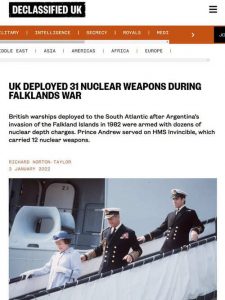
The report from the Declassified UK site that revealed the shipment of nuclear weapons by Great Britain to the South Atlantic are just some of the questions that resurfaced after the renowned journalist Richard Norton Taylor published the content of the top secret files on the Declassified UK site. of the British Ministry of Defense during the war that pitted the constitutional monarchy of the United Kingdom against the military dictatorship of Argentina for the sovereignty of the islands. In an interview with Infobae , the lawyer, historian and renowned researcher of the Malvinas issue, Alejandro Amendolara warned that the declassified report specified the amount of weapons that had reached the Atlantic, the ships that brought them, but did not go into more details than what had already been reported in 2003, when the details of the deployment of nuclear weapons were released. what the English had done to reestablish colonial rule in the archipelago. —What is the news that the latest declassification of the Malvinas War archives brought? — The National Archive revealed documents that provide new information on what nuclear weapons were brought to the South Atlantic, what quantity and on what ships, but the issue had already become public in 2003, with a report from the Ministry of Defense of the British government that, before completing the 30 years required for declassification, reveals documents that address the transport of nuclear weapons in the so-called Operation Corporate, which is how the sending of troops is known. — Regardless of what I knew, the precision of how many nuclear weapons were on ships that participated in the war was shocking. — It is true, now it is important that people do not have the image in their heads that a mushroom cloud was being searched for in Buenos Aires or Córdoba, as was revealed. The idea that they wanted a Hiroshima or a Nagasaki in South America is not true . The reality is quite different. —What you are saying is that they brought those atomic weapons so as not to use them? — After the recovery of the Malvina Islands, on April 2, Margaret Thatcher's government makes the decision to recover colonial rule and sends a fleet with frigates, aircraft carriers, destroyers, submarines and other ships. In some of those, such as The Hermes and the Invincible, which are the ones that gather almost all of the nuclear submarine charges, that weaponry was part of their usual supply, it is not that they sent to supply themselves with the bombs to attack Argentina with nuclear weapons.
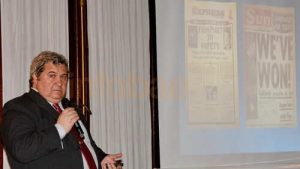
The historian Alejandro Amendolara, in a talk about the Malvinas — What were those “submarine charges” that the declassified archives talk about? — They are the WE.177 bombs . They were anti-submarine bombs from the 1960s, with an estimated power of half a kiloton, with nuclear potential and that had a devastating effect on a submarine.They had it as part of the NATO agreements and it served as weapons against nuclear submarines, mainly Soviet ones. We are analyzing the Malvinas conflict without keeping in mind the Cold War and the Soviet threat it represented to the West.
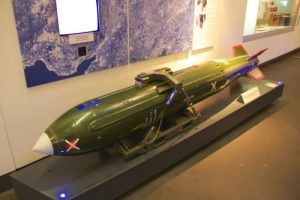
Type of nuclear depth bombs carried by British ships. —So they brought nuclear weapons more because of the Soviets than because of Argentine naval power? —Within NATO, the countries had an agreement and a coordinated defense policy to confront the Soviet Union. The ships that came to the South Atlantic had been in the passage between Great Britain and Iceland and others had finished naval exercises in Gibraltar. Some ships went to England and others, from where they were, headed with the weapons they had. In fact, in other files that I was able to review, the transfer of weapons from some ships to others is required. —Where were the Hermes and the Invincible mentioned in these declassified documents? — They were in Portsmouth, and the ships that were in Exercise Springtrain near Gibraltar were instructed to head south and the ships go with what they have inside. There was no desire for all ships to carry atomic bombs. No. That did not happen . An important issue that occurred at that time is that the Soviet Union was very active and the Cold War, at its peak, meant that every military movement took that context into account. In fact, it was confirmed that there were reconnaissance of the USSR that they flew over British positions at sea.
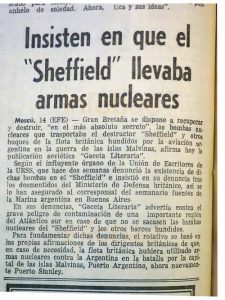
News about the sunken ship "Sheffield" and the suspicions of the presence of nuclear weapons, published by the newspaper La Prensa, on July 15, 1982 (Alejandro Amedolara) — The nuclear issue was always present, even during the war, where Argentina denounced the existence of atomic weapons... — Yes. In fact, the Argentine complaints were based on the fact that the presence of nuclear submarines and atomic weapons violated the Treaty of Tlatelolco, which prohibited nuclear weapons on the continent and adjacent maritime territory. The curious thing is that Argentina was one of the countries that had not signed it - the Alfonsín government recently did so. The Soviet Union and the United Kingdom joined this claim, in order not to compromise their alleged "right of defense", announced the withdrawal of the theater of atomic weapons operations. — According to the secret documents known so far and the testimonies and evidence, there is confirmation or suspicion of the use of some nuclear weapons during the War. —There was no confirmation or evidence that bombs or other types of weapons had been used. Yes, there were complaints about the operation of nuclear submarines in the South Atlantic . (NdR: in fact, the nuclear-powered submarine Conqueror sank the Cruise General Belgrano on May 2, 1982).
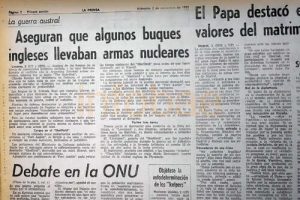
News published by the newspaper La Prensa in November 1982 — Simultaneously with the revelation of the transport of nuclear weapons to the South Atlantic, the myth of a bombing of Córdoba was revived. Did those plans actually exist? —The version came from Alí Magoudi, François Mitterrand's psychoanalyst. Beyond the respect it deserves, it is one person's version of what another person said in a conversation with a third person. In the files that I consulted I did not find data on that plan to bomb Córdoba. For now, the nuclear material that had been sent on the ships were depth bombs for submarines, they were not nuclear missiles. These types of actions had to be carried out by plane and, only Vulcan planes could carry out an attack of that type. The problem with an operation of this type was, in principle, one of scope. —Had Chile not shown itself willing to collaborate with Great Britain? — No. There are documents that confirm that the Chilean Air Force analyzed what would happen if it provided cooperation and assistance to a bombing. They knew that they could be attacked by Argentina, which is why they were not willing to participate in an action of that type. But the important thing here is that bombing Córdoba implied an operation of enormous magnitude. Pucará was manufactured there and other aircraft were maintained, but Their bombing did not represent a strategic military value. But the most complicated thing for the United Kingdom is that an attack on the continent would have changed the entire logic of the war.
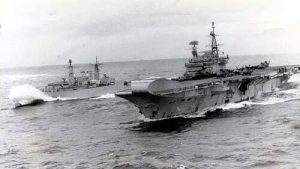
Thatcher sent 30 nuclear surface charges on the Hermes and the Invincible. - In what sense? — Attacking the continent could generate a more active commitment and solidarity from the countries of South America. A bombing of Córdoba was impossible. It is one thing to bomb a runway in the south or even the intention that existed to attack in Río Grande to neutralize the planes Super Etendard and the Exocet missiles that had caused enormous damage to the Royal Navy, but to bomb Córdoba involved flying over countries neighboring Argentina that had to give their authorization. None would have been complicit in such an act.
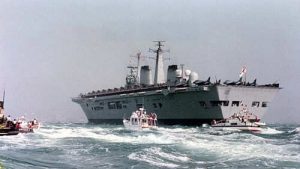
The revelation of the transport of nuclear weapons to the conflict zone in the South Atlantic generated a strong political impact. In June 2019, Infobae published an extensive and exclusive report that detailed the details of the failed “Operation Mikado”, a secret war action that never took place and that sought to destroy both missiles and planes in Tierra del Fuego and even eliminate the pilots who had attacked the English Navy. “We must destroy the Exocets missiles, eliminate the Super Étendard planes and kill the pilots in Rio Grande no matter what,” ordered Margaret Thatcher, according to the revelation of journalist Loreley Gaffoglio. —Can you say that the bombing of Córdoba is a myth then? — I don't know. The truth is that there is no document so far that mentions that operation. We must keep in mind that, throughout the war, the British analyzed the different options and pointed out the pros and cons. Beyond the fact that Thatcher imposed In his vision, the Foreign Office's view had decisive weight: an attack on the continent was going to be very difficult to defend diplomatically.
In any case, Amendolara himself detailed in an extensive article published in Infobae in April 2019 something that did happen and that was the design of a secret plan by the English to bomb Buenos Aires. “The declassified information in the British archives reveals that There were plans to drop bombs from Vulcan planes on the capital.“Attack on selected targets on the Continent,” say the documents that detail the strategies that were being perfected or discarded depending on the evolution of the conflict.






